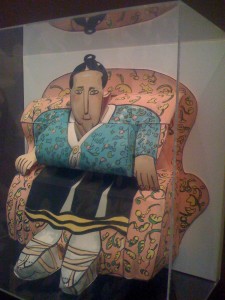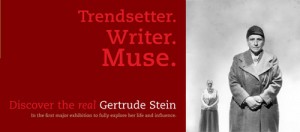
Yes they did it. They pulled it off. The Contemporary Jewish Museum, arm in arm with the Smithsonian Portrait Gallery in DC (where the show will go from San Francisco) made it happen: the long-awaited exhibition Seeing Gertrude Stein: Five Stories, the first-ever attempt to portray Stein in an exhibition, is a marvel of a show.
A dozen years in the making, the exhibition is as “peaceful and exciting” as Gertrude could have wished for. Everybody – scholarly Steinians, would-be-Steinians, “Gertrude Stein who?”-Steinians, youngsters, hipsters and the rest can and will and must enjoy the portrait of the genius who has enlightened, puzzled and troubled our world for a good 100 years.
The immediate impression – that’s all I can give so far – is that Gertie, Gertrude, Gertrude Stein and Gertrude and Alice are all palpably present (in three dimensions like the 1975 pop-up Stein by artist Red Grooms shown above) and that the show is just like her: sumptuous, good-humored, highly intelligent, brainy and eccentric, sophisticated and unpretentious all at the same time.
From the entry, where Stein’s famous line “When this you see remember me” crosses a wall, the eye catches the big Buddha-like sculpture of the author by Jo Davidson (permamently enthroned in Manhattan, in front of the Public Library). A break in the wall behind it opens onto the blue-and-white pigeon wall-paper that used to cover a whole room in Gertrude and Alice’s second Paris apartment, on Rue Christine, and here merrily covers the entire museum wall. A small video screen nearby shows Stein with thick-rimmed glasses, reciting her poem,
“Pigeons on the grass alas.
Pigeons on the grass alas.
Short longer grass short longer longer shorter yellow grass Pigeons large pigeons on the shorter longer yellow grass alas pigeons on the grass.”
Then she looks at the camera with an ambiguous half-grin and states that this was exactly what she saw: pigeons on the grass, in her yard. There you have it. It’s as simple as that.
Another wall is covered with an oversized, pleased-looking Stein presenting her brand-new evening suit tailored by fashion designer Pierre Balmain. In “Story 2: Domestic Stein”, two of her beautiful, elaborately embroidered vests, both perhaps made by Alice, round out Stein’s sensuous presence.
In the cornucopia of photographs, original art work, posters and of course books, there is enough of the familiar (the art-covered studio walls at 27 Rue de Fleurus, the portraits of Stein by all the famous photographers and artists, the Ford, the dogs and the country house) to set a solid base for the intention of the show to present Stein’s less familiar faces.
“Everyone has their own narrative on who is Gertrude Stein,” the two curators of the show, scholars Wanda Corn and Tirza Latimer, explained in the opening lecture. Instead of the well-known Stein, the “patron collector, the Stein of the Lost Generation, or the difficult-to-read Stein,” they wanted to present the “unknown Stein” as well as the “visual Stein,” i.e. the writer who inhabited a visual world and insisted that for writing, eyes “were more important than ears.”
Seeing Gertrude : Five Stories focuses on the period between 1920 and 1946, when Stein could no longer afford to buy Picasso or Matisse and instead collected affordable artists from all walks of life who were young, gay, and admiring (part of “Story 3: The Art of Friendship”). The curators were interested in the American rather than the expatriate Stein (“Story 4: Celebrity Stein” with the US Lecture Tour). They did not want to present Stein as the lonesome genius, but as the collaborator with other artists who became her “second family.”

The exhibition certainly succeeds in making Stein “visual.” There is an abundance of multimedia: movie footage and a two-hour slide show of photographic images in “Story 1: Picturing Gertrude Stein,” showing what Stein looked like in her various bohemian and post-bohemian, monk- and dyke-style outfits. There are marvelous audio-samples of the author reading from her work and there are many filmed excerpts from her collaborations – her two operas and her one ballet – in rare historical and modern versions.
“Stein has always evoked passionate responses,” the exhibition tells us. “She paraded, even celebrated, her contradictions. Her literay innovations were radical but her political beliefs conservative. She was a lesbian who perferred the intellectual company of men. She was born and raised a Jew but did not give Judaism a central place in her public identity. A self-acclaimed genius, she preferred talking to the man in the street rather than those in power. She was an expatriate who wanted to be famous in her home country. She was beloved but also feared and disliked. Seeing Gertrude Stein: Five Stories explores this complex and fascinating woman.”
Not all of these contradictory facets are visible or easily detectable in the exhibition. One story – the Jewish story –- seems to be entirely missing. We will have to wait for the catalogue-book, to be published any day by UC Press, to find out why, and find out more.
Stay tuned.



